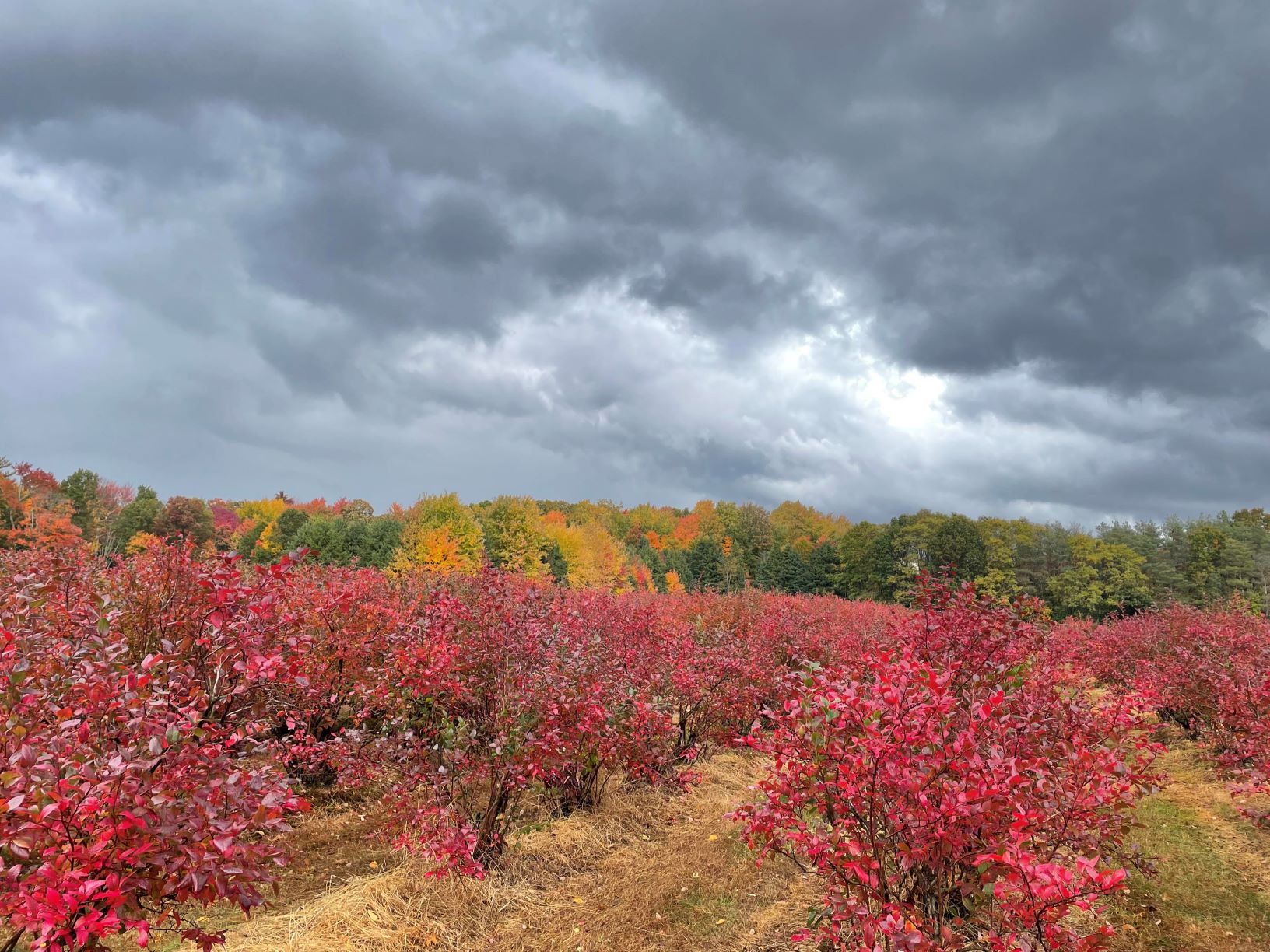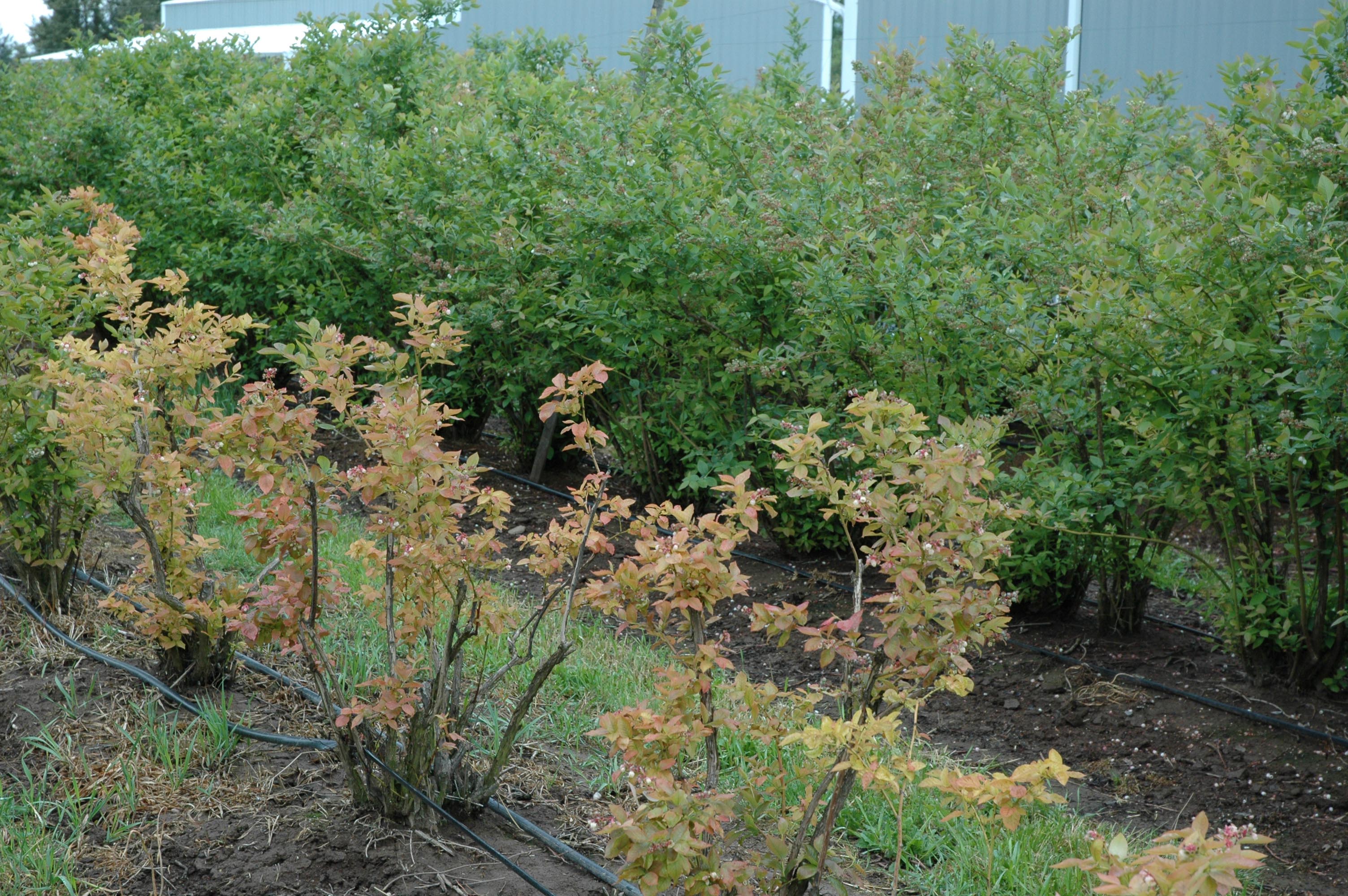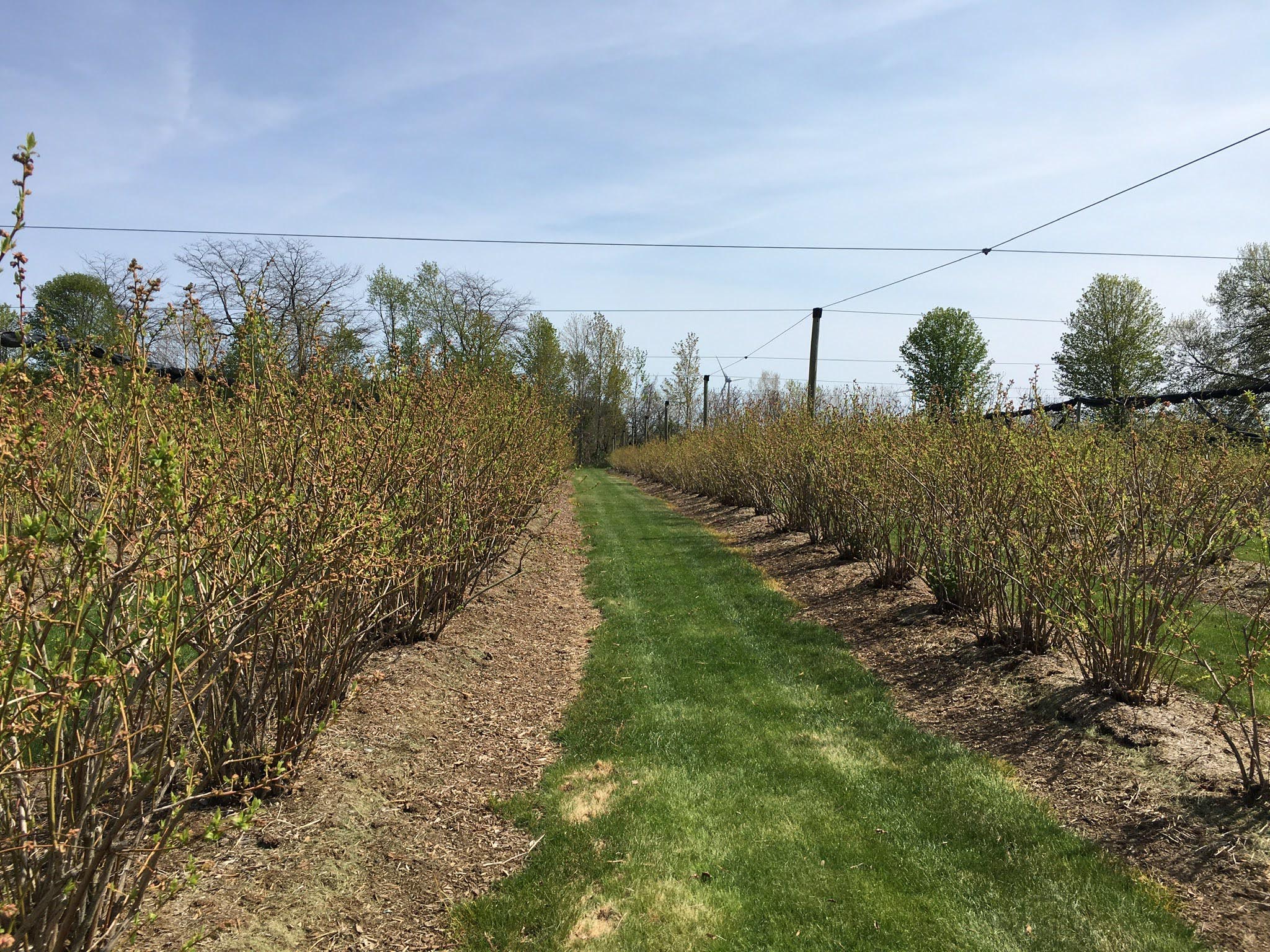Growing blueberries for home gardens and small scale production
Learn things to consider for planting, care and selecting blueberry varieties for the home garden.
ISSN 1198-712X, Published February 2023
Introduction
Blueberry bushes are long-lived plants with a lifespan similar to fruit trees. The berries are versatile and can be enjoyed fresh, used in desserts or stored by canning or freezing. In addition, the plants provide ornamental value with their delicate white blossoms in the spring and fiery foliage in the autumn (Figure 1).
Some examples of commercial production are provided as examples of best management practices but may not be relevant to small garden production. Highbush blueberries grow and survive best in the milder regions of Ontario. Mid-winter temperatures of −29°C to −32°C can severely injure or kill both flower buds and young branches. In marginal areas for highbush blueberry cultivation, deep snow cover throughout the winter will help insulate the plants and reduce the extent of winter injury. The parts of the bushes that are protected by snow may produce a crop. Different blueberry cultivars also vary widely in their degree of winter hardiness. Lowbush or half-high blueberries (refer to Cultivars) may survive in colder regions that receive adequate and reliable snowfall.

Planting site
Blueberries prefer full sun, although the plants will tolerate partial shade. As shade increases, the bushes produce fewer blossoms, and fruit production declines.
Blueberries require acidic, well-drained, loose soils with a high organic matter content. Good drainage is important because the very fine root system needs adequate aeration. The roots of blueberries will suffocate if they remain in water-saturated soil for even a few days. Water tables should always remain at least 30 cm below the soil surface. Avoid low-lying locations since they may be poorly drained and prone to frost.
The pH of the soil is critical for blueberry growth. Blueberries grow best at a pH of 4.5–5.0, although they may tolerate a higher pH of up to 5.5. A soil test can determine the soil pH. If the soil pH tests between 5.0 and 6.5, apply sulphur to acidify the soil and reduce the pH. If the soil pH tests higher than 6.5, adding sulphur will not adequately reduce the pH, so the soil is not suitable for blueberry production.
Soil preparation
Since blueberry bushes will live and produce berries for many years, take special care to adequately select and prepare the soil before planting blueberries. Prepare the site one full year prior to planting.
Organic matter
Organic matter improves soil aeration and drainage while retaining moisture and nutrients. Blueberries establish better, grow more vigorously and yield more fruit if organic matter is incorporated into the soil before planting. Acid peat moss is the preferred source of organic matter. Work 10–15 cm of acid peat thoroughly into the top 15–20 cm of soil. Acid peat will also help lower the soil pH. Other sources of organic matter include well-rotted manure, straw, compost or aged sawdust.
Soil pH
If the soil pH tests between 5.0 and 6.5 on a well‑drained, sand to sandy loam soil, add sulphur to lower the pH to between 4.5 and 5.0. Apply sulphur the year before planting and thoroughly mix it into the top 20 cm of soil. The amount of sulphur required to lower the pH differs for each soil. As a guide for sandy loam soils, add 75–100 g/m2 for each full point the soil registers above 4.5. (For example, if the pH is 6.5, add 150–200 g/m2.) For sandier soils, use 35–50 g/m2. Since sulphur takes several months to reduce the pH, wait a few months before re-testing to determine if more sulphur is required.
Soils that have a pH above 6.5, poor drainage or a clay texture are not suitable for blueberry production. A raised bed could overcome problems such as drainage. To create a raised bed, replace some of the soil with 8 cm of coarse material such as gravel or crushed stone to provide good drainage. On top of this coarse material, add a minimum of 30 cm of a mixture of half sandy topsoil and half acid peat. Use logs, stone or bricks to contain the soil mixture. Before planting, check to ensure the pH of the bed is 4.5–5.0.
Weeds
Eradicate all perennial weeds such as quackgrass, bindweed and vetch in the year before planting. Cultivate or pull weeds before they begin to produce seeds.
Fertilizer
Before planting blueberries, incorporate phosphorus and potassium into the soil according to soil test results.
Planting
Plants
Use strong, dormant 2- or 3-year-old plants that are free from viruses and diseases. Obtain plants as close to planting time as possible. If necessary, plants will store for short periods in a refrigerator or other cool place. Sprinkle dry roots with water and place bare‑rooted plants in plastic bags before storing. Do not leave roots soaking in water or they will die. If plants must be held for more than 1 or 2 weeks, dig a trench in well-drained soil, set plants in the trench and cover the roots with soil. Potted plants should be stored in a cool place. Water the plants if the soil moisture is low.
Planting distances
Set highbush blueberry plants 1.0–1.5 m apart within the rows. The distance between rows will vary from 1.5–3.0 m apart, depending on available space, aisle width desired and any machinery requirements. Planting rows 1.5 m apart will result in a walking aisle only. Spacing rows 3 m apart will accommodate most machinery.
Planting method
Plant the dormant blueberry bushes in early spring as soon as the soil can be worked. Prune any broken roots or branches and set the plants 3–5 cm deeper than they were grown in the nursery. Spread out the roots and cover them with soil. Firm the soil around the roots, being careful not to cause breakage. Blueberry roots are very fine and must not dry out at any time during planting. Water the bushes thoroughly after planting.
Care of plantings
Blossom removal
Remove blossoms as they appear during the first and second season. This helps the plants establish quickly and grow more vigorously.
Weed control, mulching
Blueberries have a shallow root system that is easily damaged by cultivation or deep hoeing. Mulching the plants with sawdust, wood shavings or clean straw will aid in weed control and help conserve moisture. Make sure the mulch is moist before applying it. Spread the mulch in a band 60 cm wide, with 30 cm on each side of the plant row. Add mulch to a depth of 5–10 cm. Grass, such as creeping red fescue, can be planted and allowed to grow between the mulched bands if the sod is mowed regularly.
As the plants grow larger, gradually widen the mulched area to 60 cm on each side of the bushes. Add mulching material as required to maintain a mulch depth of 5–10 cm.
Immediately remove any weeds that grow through the mulch since broadleaf weeds and grasses compete strongly with blueberries for moisture and nutrients. Never allow weeds to produce seed.
Fertilizer
Use fertilizer mixtures that supply nitrogen as ammonium sulphate (when the soil pH is above 5.0) or urea (when the soil pH is below 5.0). Supply potassium in the form of potassium sulphate or sul-po-mag. Avoid muriate of potash, since it contains chloride that can be toxic to blueberries.
Potassium and phosphorus should be applied according to soil test results. In the year following planting, apply 14–18 g of nitrogen per highbush blueberry plant, in addition to the potassium and phosphorus. (This rate of nitrogen would be contained in 140–180 g of a 10-10-10 fertilizer.) Increase the rate of nitrogen each year by 4–6 g per bush until a total of 36–48 g per bush is applied. Apply the fertilizer just prior to budbreak. On sandy soils, apply two-thirds of the nitrogen at budbreak and the other third at petal fall. Distribute all fertilizer evenly under the bushes to just beyond the spread of the branches.
Check the soil pH every year or two, especially if plant growth is poor. Iron deficiency is common when the soil pH is too high (Figure 2). Normally, young leaves are a lighter green than older leaves and often have a slight reddish tint. When deficient in iron, young leaves become pale yellow and stunted, and plant growth is poor. If iron deficiency occurs, make every effort to correct the soil pH. Water or lightly rake sulphur into the soil or mulch according to the pH. To avoid possible burning of the blueberry roots, delay the sulphur application until 1 month after applying the fertilizer. Foliar sprays of iron chelate can temporarily correct an iron deficiency, but annual sprays may be necessary.

Watering
Blueberries have shallow roots and require a uniform and adequate moisture supply throughout the growing season. A constant moisture supply ensures good plant growth and fruit production. Mulch reduces moisture fluctuations and significantly improves moisture conservation. As a guide, blueberries require 10–20 L of water per bush per day until early September. Watering is essential whenever rainfall does not supply this amount. To encourage the plants to harden off before winter, do not water after early to mid-September unless the soil becomes very dry. Avoid overwatering the plants, or the roots will be injured and killed.
Blueberries respond well to trickle or drip irrigation. The system slowly adds small amounts of water each day directly to the soil around the base of each plant. Fertilizer can also be applied through the irrigation system. Both automated and manually operated systems are available. Several manufacturers sell trickle irrigation that can be used in blueberries.
Harvesting
Berries develop in clusters of 5–10 berries and ripen over a period of 4–6 weeks. Blueberries are often harvested too early. After the berries turn completely blue, leave them on the bushes for 3–7 days to develop their full flavor and sugar content. To free both hands for picking, attach the basket to a belt at waist level. Gently roll the berries between the thumb and forefinger, removing fully ripe berries and leaving unripe berries for the next picking. Berries that shrivel or split have probably remained on the bush too long. Harvested berries should be removed immediately from the sun and cooled, and can be stored for a week or more in the refrigerator if kept dry.
Bird control
Birds find blueberry fruit very attractive and can eat the entire crop of a small planting if it is not protected. To prevent losses, cover individual bushes or the entire planting with netting supported by a light framework (Figure 3). Put up the netting just before the berries turn blue. The netting should not shade the plants, or they will not flower well the following year. Remove the netting after harvest to avoid damage from winter ice and snow.

Pruning
Prune highbush blueberries while the plants are dormant in late winter or early spring after the threat of extremely cold temperatures has passed. Avoid pruning too early in the winter. Pruning stimulates the plants, causing them to lose some dormancy and increasing their susceptibility to winter injury.
Young bushes require little pruning in the first 3 years. Remove flower blossoms, any damaged or diseased portions of branches and any weak, spindly growth at the base of the plant. Encourage vigorous, upright growth.
Older bushes require regular annual pruning to produce high yields of large fruit. Fruit will develop on strong 1-year-old wood with good exposure to sunlight. First, prune out any dead, broken, injured or diseased branches. Next, remove any canes that are spindly or growing near or along the ground. Finally, cut off at ground level canes low in vigour, canes older than 5 years and any canes larger than 5 cm in diameter. Keep 12–16 vigorous canes per bush. If winter injury is not severe, select 1 or 2 of the new shoots to keep and remove the remaining young shoots. These new shoots will eventually replace the older canes.
Winter protection
Different blueberry cultivars vary in their ability to withstand winter cold; however, cultural practices will also influence winter hardiness. Any conditions that stimulate growth of the plants late in the season will increase their susceptibility to winter injury. Apply moderate rates of nitrogen early in the spring, avoiding applications beyond June. Avoid watering late in the fall, unless the soil is excessively dry. Do not prune in late fall to early winter, or plants will lose some of their winter dormancy.
Young branches of blueberry plants are attractive to rabbits. Most of the damage from rabbits occurs during the winter when other food is scarce. If rabbits are present, it may be necessary to enclose the sides of the planting with a fine chicken-wire fence or netting. Make sure the sides are high enough that the rabbits cannot jump over the fence when the snow is fairly deep.
If grass is planted between the rows, mow the sod short late in the fall to discourage mice from nesting near the blueberries. If mice are abundant, reduce populations by placing poisoned bait into bait stations in areas frequented by mice.
Yields
Blueberry plants will remain productive for 20 years or more if growing conditions are good and if plants are healthy and properly pruned. Highbush blueberry plants should produce about 225 g of berries per bush in the third year, and about 450–900 g per bush in the fourth year. Yields should increase until the plants are 6–8 years old. A mature bush should produce 2.5–3.5 kg of berries, although higher yields are possible.
Cultivars: earliest to latest
Plant several different blueberry cultivars for cross‑pollination, to extend the harvest season and to determine which cultivars perform best under the conditions provided.
Patriot
Early mid-season, productive. Plants are small to medium sized, vigorous, upright and very hardy. Fruit clusters are tight; berries are medium blue, very large, slightly flattened, firm, with very good flavour. Good ornamental value.
The colder regions of Ontario are only marginally suitable for high-bush blueberries. Lowbush blueberries or half-high blueberries may survive better, especially if snow insulates the plants throughout the winter.
Northland
Early mid-season, very productive. Plants are slightly short, bushy, moderately spreading and very hardy. Fruit clusters are long and loose; berries are medium to dark blue, medium-small, moderately firm, with good flavour. Very good ornamental value.
Bluecrop
Mid-season, productive. Plants are vigorous, upright, open and hardy. Fruit clusters are loose; berries are light blue, large in size, very firm, with a good, slightly tart flavour. Fall leaf colour is a medium dark red.
Blueray
Mid-season, productive. Plants are vigorous, erect and fairly hardy. Fruit clusters are small and tight; berries are medium to dark blue, very large, firm, aromatic, with good flavour. Blossoms are reddish and fall leaf colour is a medium dark red.
Jersey
Late mid-season, productive. Plants are large, bushy, upright and hardy. Fruit clusters are loose; berries are medium blue, medium sized, firm, with fair flavour, lacking aroma. Fall leaf colour is a light, bright red.
Lowbush blueberries
Lowbush blueberries are low, spreading plants that often grow wild in northern regions of Ontario. Lowbush blueberries produce small to medium sized, flavourful berries. Cultivated low‑bush blueberry planting stock is available. Lowbush blueberries should be planted 50 cm apart in rows 100–150 cm apart. Plant lowbush blueberry crowns 3–5 cm below the soil surface to promote spreading of the plants by underground rhizomes.
Half-high blueberries
Half-high blueberries resulted from crossing lowbush and highbush blueberries together. Northblue is a vigorous half-high blueberry that reaches 50–75 cm in height. Northblue produces dark blue, large, firm berries. St. Cloud is a large half-high (100–120 cm) with an upright growth habit. Fruit is medium blue, large and slightly flattened. Northcountry is a smaller half-high (45–60 cm) that produces sweet, mild, sky‑blue blueberries. Plant half-high blueberries 60–75 cm apart.
Control of insects and diseases
Spotted wing drosophila (SWD) lay eggs in healthy, ripening and ripe berries. Once the larvae hatch, they begin to feed inside the berry, causing the berry to collapse. SWD is a chronic pest in berry crops in Ontario. Regular harvest (every 1–2 days) and storing the fruit in the refrigerator as soon as possible after harvest are important practices to reduce damage from SWD.
Cherry and cranberry fruitworm moths lay their eggs on newly set blueberries just after bloom. Cherry fruitworm larvae bore into the berries and tunnel into adjacent berries, lining the junctions with silk. Cranberry fruitworm larvae burrow into the berries near the stem end and feed inside the berry. Infested berries shrivel and turn blue prematurely. The larvae web together infested and uninfested fruit with stands of silk and pellets of frass. To control both fruitworms, remove and burn infested berries promptly to destroy the larvae inside before they exit and pupate.
Careful pruning will help prevent disease outbreaks. Prune out and destroy any part of the plant that is dead or dying. Examine the plants frequently for cankers that first appear as small, reddish, discoloured areas on the stems. As the affected areas enlarge, the margins remain reddish and the bark in the central part turns grey and then brown. Cankers often occur close to the ground level but may occur higher on the stem. Cankers can girdle the blueberry stems in one season, causing the affected stem to die. As the stems die, the foliage turns reddish brown (Figure 4). If cankered stems appear, immediately cut out the affected parts 10–15 cm below the cankered area. Remove and burn the diseased prunings.
This fact sheet was originally written by Kevin Schooley, horticultural crops advisor, and Leslie Huffman, weed management advisor, Ministry of Agriculture, Food and Rural Affairs (OMAFRA). It was updated by Erica Pate, fruit crop specialist, OMAFRA.